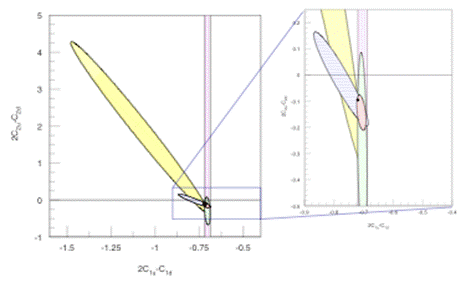Measurement of Parity Violation in Deep Inelastic Scattering
A triumph of modern physics is the unified description of the electromagnetic and weak forces into a single framework - the Standard Model. One fascinating feature of the Standard Model is that left- and right-handed particles interact in ever so slightly different ways, an effect known as parity violation. When an accelerator fires a high-energy electron at a nucleon and the electron scatters from a single quark, the Standard Model predicts this difference to be about 1 part in 10,000. A deviation would indicate that the Standard Model’s prediction of the reaction strength (coupling) is wrong. Researchers in the Medium Energy Physics group and collaborators have made the world’s most precise measurement of this difference using the CEBAF accelerator at the Thomas Jefferson National Accelerator Facility (JLab). With this measurement, the vector-electron to up (down) axial-quark coupling, known as C2u(d) was determined. The Standard Model predicts these values very precisely [1] but measurements [2] of this quantity lacked the precision of other parameters of the Standard Model. These results, first published in Nature [3] and later detailed in Physical Review C [4] are illustrated in the figure below; these new data confirm the predictions of the Standard Model, shown as a black point. While the precision of the new measurement is significantly better than all previous measurements, the SoLID collaboration has proposed even more precise measurements with the JLab 12 GeV upgrade.

Fig.1: A comparison of the new results [3,4] (blue ellipse) with previous measurements [2] of the quark weak axial charge combination 2C1u-C1d vs. 2C2u-C2d and with a combined analysis using all of the available data (red ellipse). The prediction of the Standard Model [1] is shown as a black dot, in good agreement with the improved measurements. The right plot provides an enlargement of the region of interest.
References
- J. Beringer et al. (particle Data Group), Phys. Rev. D86 010001 (2012).
- C. Y. Prescott, et al., Phys. Lett. B77, 347 (1978), C. Y. Prescott, et al., Phys. Lett. B84, 524 (1979), and E. J. Beise, M. L. Pitt, D. T. Spayde, Prog. Part. Nucl. Phys. 54, 289 (2005).
- D. Wang et al. (The Jefferson Lab PVDIS Collaboration) Nature 506, 67–70 (06 February 2014).
- D. Wang et al. (The PVDIS Collaboration) Phys. Rev. C 91, 045506 (2015).
![[Argonne Logo]](/images/argonne_header_logo.jpg)
![[DOE Logo]](/images/header_doe.gif)